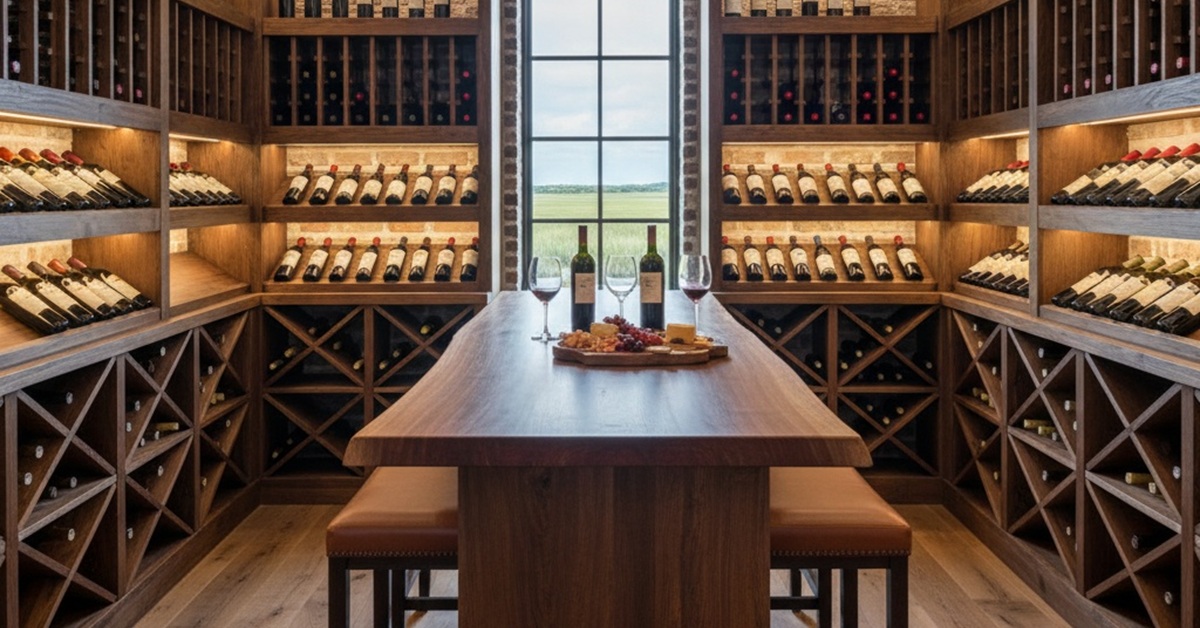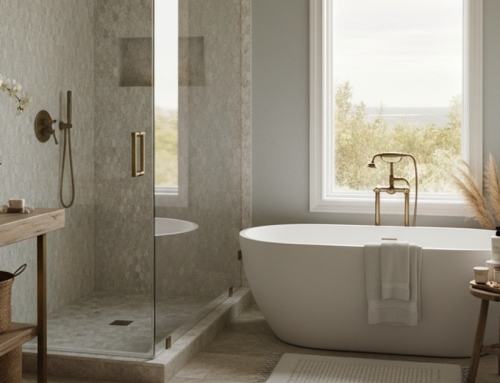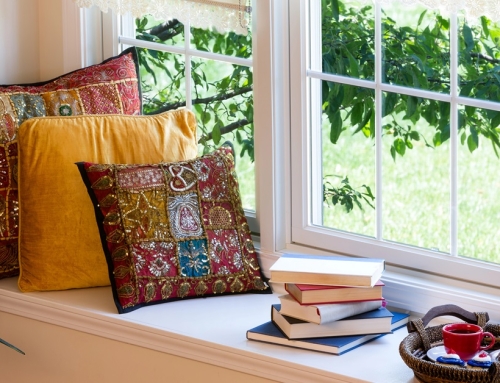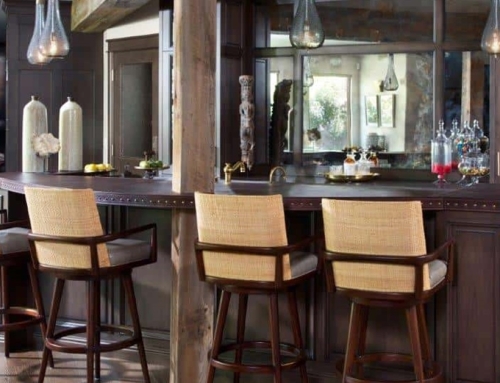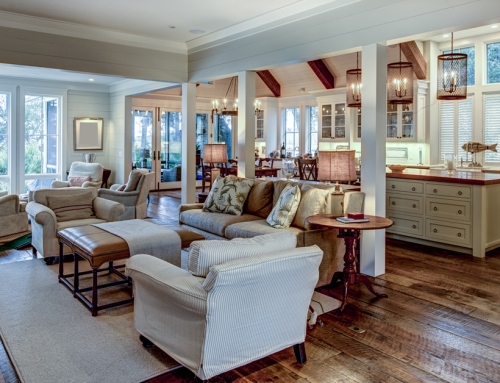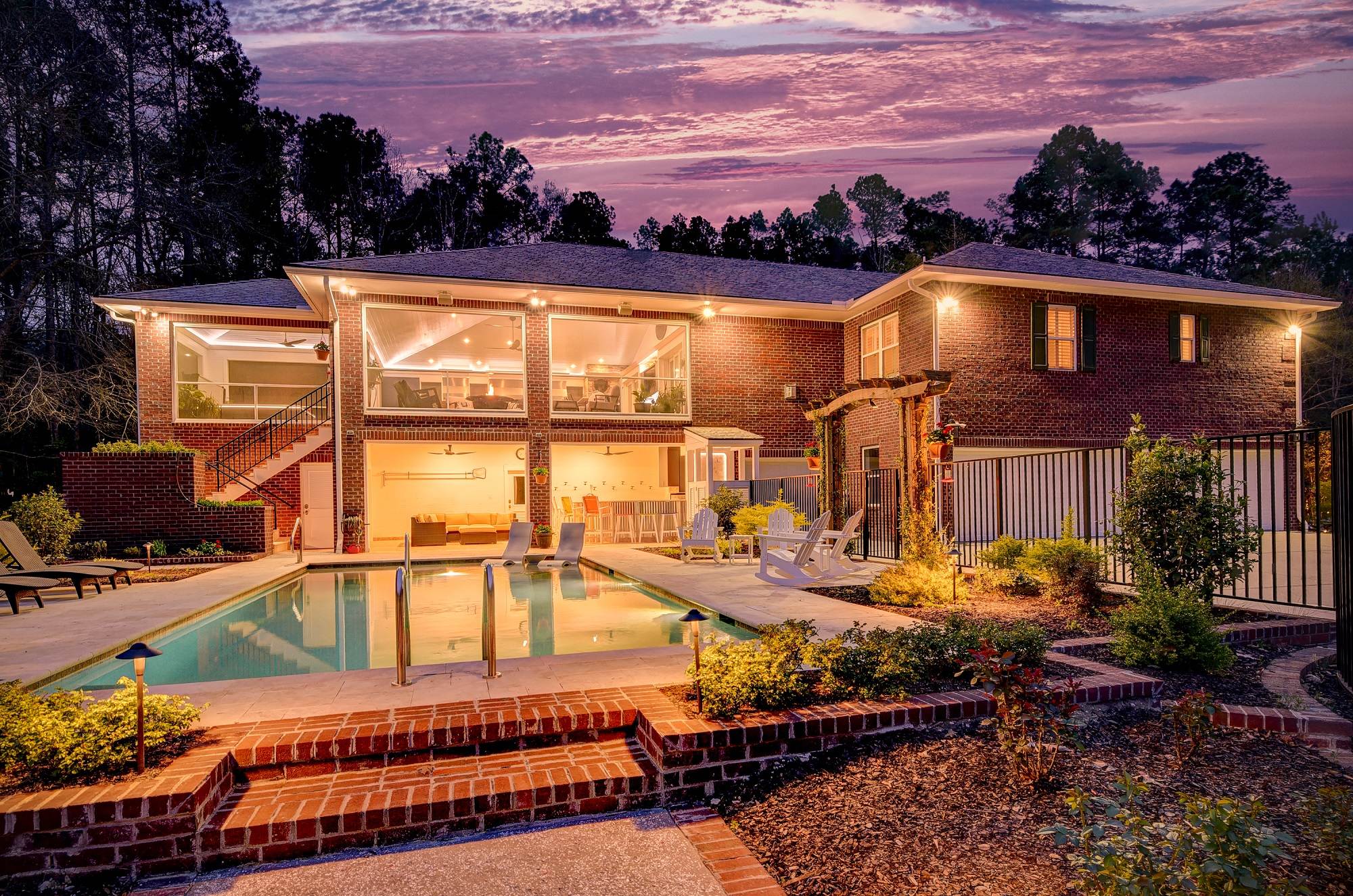There’s something deeply satisfying about having a properly curated wine collection at your fingertips – bottles carefully selected over years, each with its own story, all preserved in perfect conditions and ready to enhance any occasion. For luxury homeowners in the Lowcountry, a custom wine cellar represents more than just storage; it’s a statement of sophistication, a conversation piece, and a functional work of art that protects a valuable investment while creating memorable entertaining moments.
If you’re envisioning a wine cellar that will be ready for summer 2026 entertaining season – when guests gather on warm evenings and the perfect bottle can elevate any celebration – now is the ideal time to begin planning. With a seven to eight-month design and construction timeline, starting your project this winter ensures your collection will be beautifully housed and perfectly preserved when you need it most.
The Lowcountry Challenge
Designing a wine cellar in the South Carolina Lowcountry presents unique challenges that demand expert attention. Our climate – characterized by high humidity, significant temperature fluctuations, and coastal conditions – is essentially the opposite of what wine needs to age gracefully. Wine thrives in cool, stable environments with controlled humidity, typically around 55-58 degrees Fahrenheit with 60-70% humidity.
This is where thoughtful design and quality construction become critical. A properly designed wine cellar isn’t simply a cool room with racks; it’s a precisely engineered environment that maintains ideal conditions regardless of what’s happening outside. This requires careful attention to insulation, vapor barriers, climate control systems, and construction details that many general contractors simply don’t understand.
The investment in proper design and construction pays dividends immediately and for years to come. Your collection – whether it includes everyday favorites or investment-grade bottles – deserves protection. Temperature fluctuations can cause corks to expand and contract, allowing air into bottles and ruining wine. Excessive humidity promotes mold growth, while insufficient humidity dries out corks. A professionally designed wine cellar eliminates these concerns entirely.
Climate Control: The Foundation
The heart of any wine cellar is its climate control system. This isn’t a standard HVAC unit; wine cellars require specialized cooling systems designed specifically for this purpose. These units maintain precise temperature and humidity levels, run efficiently, and operate quietly – important when your wine cellar is integrated into your home’s living spaces.
Sizing the cooling system correctly requires careful calculation based on the cellar’s dimensions, insulation values, glass exposure, and ambient conditions. Undersized systems run constantly and fail prematurely; oversized systems cycle too frequently and can’t maintain stable conditions. This is where working with experienced designers makes all the difference.
Modern wine cellar cooling systems offer sophisticated controls that allow you to monitor and adjust conditions remotely via smartphone apps. You can check on your collection from anywhere, receive alerts if conditions drift outside ideal parameters, and have peace of mind knowing your investment is protected even when you’re away from home.
Redundancy is worth considering for serious collectors. Backup cooling systems, temperature monitoring with automatic alerts, and emergency protocols ensure that a mechanical failure doesn’t result in disaster. For collections valued in the tens of thousands – or more – these safeguards are simply prudent.
Custom Racking: Form Meets Function
Wine racking is where functionality meets aesthetics, and custom design allows you to create exactly what your collection needs while achieving the look you envision. The options are remarkably diverse, from traditional wooden racks in rich mahogany or walnut to contemporary metal and acrylic designs that create a modern, gallery-like atmosphere.
Racking design should reflect how you use your collection. Serious collectors often want individual bottle storage that allows them to see labels and access specific bottles easily. Those who buy by the case might prefer bulk storage sections. Display rows that highlight special bottles at eye level create focal points and conversation starters. Magnum storage accommodates larger format bottles. The configuration should make sense for your collecting habits and entertaining style.
Wood selection impacts both aesthetics and longevity. Mahogany and redwood are traditional choices that resist moisture and age beautifully. Walnut offers rich, dark tones. Metal racking in powder-coated finishes provides contemporary style and exceptional durability. Many cellars combine materials – perhaps wood for the main racking with metal accents or glass shelving for featured bottles.
Capacity planning requires honest assessment. Most collectors underestimate how quickly their collection grows. Building in extra capacity now costs relatively little compared to expanding later. A well-designed cellar accommodates growth while maintaining visual appeal even when not filled.
Lighting: Setting the Mood
Lighting in wine cellars serves multiple purposes: it allows you to read labels and select bottles, it displays your collection, and it creates ambiance for the space. However, lighting must be carefully considered because heat and UV radiation can damage wine.
LED lighting has revolutionized wine cellar design. LEDs produce minimal heat, contain no UV radiation, offer excellent color rendering for reading labels, and consume very little energy. They can be dimmed to create different moods and last for years without replacement.
Strategic lighting placement enhances the cellar’s visual impact. Illuminating individual rows from above or below creates drama and makes labels easy to read. Accent lighting can highlight special bottles or architectural features. Cove lighting provides ambient illumination without glare. The goal is to create a space that’s functional for selecting wine but also beautiful enough that you want to spend time there.
Consider lighting controls that allow you to adjust brightness and even color temperature. Warmer tones create an intimate, traditional feel; cooler tones offer contemporary crispness. Programmable scenes let you set different lighting for different occasions – bright for inventory management, dim for showing guests your collection.
The Tasting Area
Many luxury wine cellars incorporate tasting areas where you can sample bottles, share discoveries with friends, or simply enjoy a quiet glass while surrounded by your collection. This transforms the cellar from pure storage into a destination within your home.
Tasting areas can range from simple – a small counter with a few stools – to elaborate spaces with full bars, seating for multiple guests, and all the amenities for proper wine service. The scope depends on available space, budget, and how you envision using the area.
Essential elements include a countertop at appropriate height for standing or seated tasting, adequate lighting for examining wine color and clarity, storage for glasses and accessories, and perhaps a small sink for rinsing glasses. Some homeowners add wine preservation systems that allow them to taste expensive bottles without opening them completely, or temperature-controlled dispensers for wines being consumed over several days.
The tasting area’s design should complement the overall cellar aesthetic while providing comfortable, functional space. Natural stone countertops, custom cabinetry, and thoughtful details create a space that feels special – worthy of the wines you’re enjoying.
Smart Technology Integration
Modern wine cellars can incorporate sophisticated technology that enhances both functionality and enjoyment. Inventory management systems track your collection, noting what you have, where it’s stored, optimal drinking windows, and current values. Some systems integrate with your smartphone, allowing you to check your inventory while shopping or dining out.
Security systems protect valuable collections with cameras, sensors, and alerts. Climate monitoring systems provide real-time data and historical tracking, giving you confidence that conditions remain ideal. Some collectors integrate their cellars with home automation systems, controlling lighting, temperature, and even music from central control panels or voice commands.
These technologies aren’t necessary for every cellar, but they add convenience and peace of mind, particularly for serious collectors with significant investments in their wines.
Design Aesthetics
Wine cellars offer remarkable design flexibility. Traditional cellars might feature rich wood tones, arched doorways, wrought iron details, and Old World charm reminiscent of European caves. Contemporary cellars embrace clean lines, glass walls that highlight the collection, modern materials, and minimalist aesthetics. Transitional designs blend elements of both, creating spaces that feel current yet timeless.
Glass walls or doors are increasingly popular, allowing you to display your collection from adjacent living spaces. Modern insulated glass technology makes this practical while maintaining proper cellar conditions. The visual impact of seeing a beautifully lit wine collection through glass is undeniably impressive.
Flooring choices range from traditional stone or tile to stained concrete or even cork. The material should be moisture-resistant, durable, and complement the overall design. Stone provides Old World elegance; stained concrete offers contemporary style; cork adds warmth and is naturally moisture resistant.
Architectural details – arched entries, custom millwork, decorative hardware, stone, or brick accents – add character and make the space feel finished and intentional rather than merely functional.
The Timeline Advantage
Beginning your wine cellar project now, in December, positions you perfectly for summer completion. The seven to eight-month timeline allows for thorough design development, careful material selection, proper permitting, and quality construction without rushing.
Winter months are often ideal for construction projects. Contractors’ schedules may be more flexible, and working on interior projects during cooler weather is often more comfortable. You’ll have time to make thoughtful decisions about every detail, from racking configuration to lighting design to the perfect stone for your tasting counter.
By summer 2026, when entertaining season is in full swing and you’re hosting gatherings on warm Lowcountry evenings, your wine cellar will be ready. You’ll have the perfect bottle for any occasion, properly stored and beautifully presented, in a space that impresses guests and brings you daily satisfaction.
Investment in Enjoyment
A custom wine cellar is an investment in your home, your collection, and your lifestyle. It protects valuable wines, creates an impressive entertaining feature, adds tangible value to your property, and provides a space dedicated to one of life’s great pleasures.
For luxury homeowners in Hilton Head Island, Bluffton, and Beaufort, a professionally designed wine cellar represents the kind of thoughtful detail that distinguishes exceptional homes. It’s a feature that you’ll use and appreciate constantly, that guests will remember, and that future buyers will value.
The key is working with designers and builders who understand both the technical requirements and the aesthetic possibilities – professionals who can create a cellar that functions flawlessly while reflecting your personal style.
Talk to a design expert at Winslow Design Studio about creating your custom wine cellar, perfectly timed for summer 2026 entertaining.


